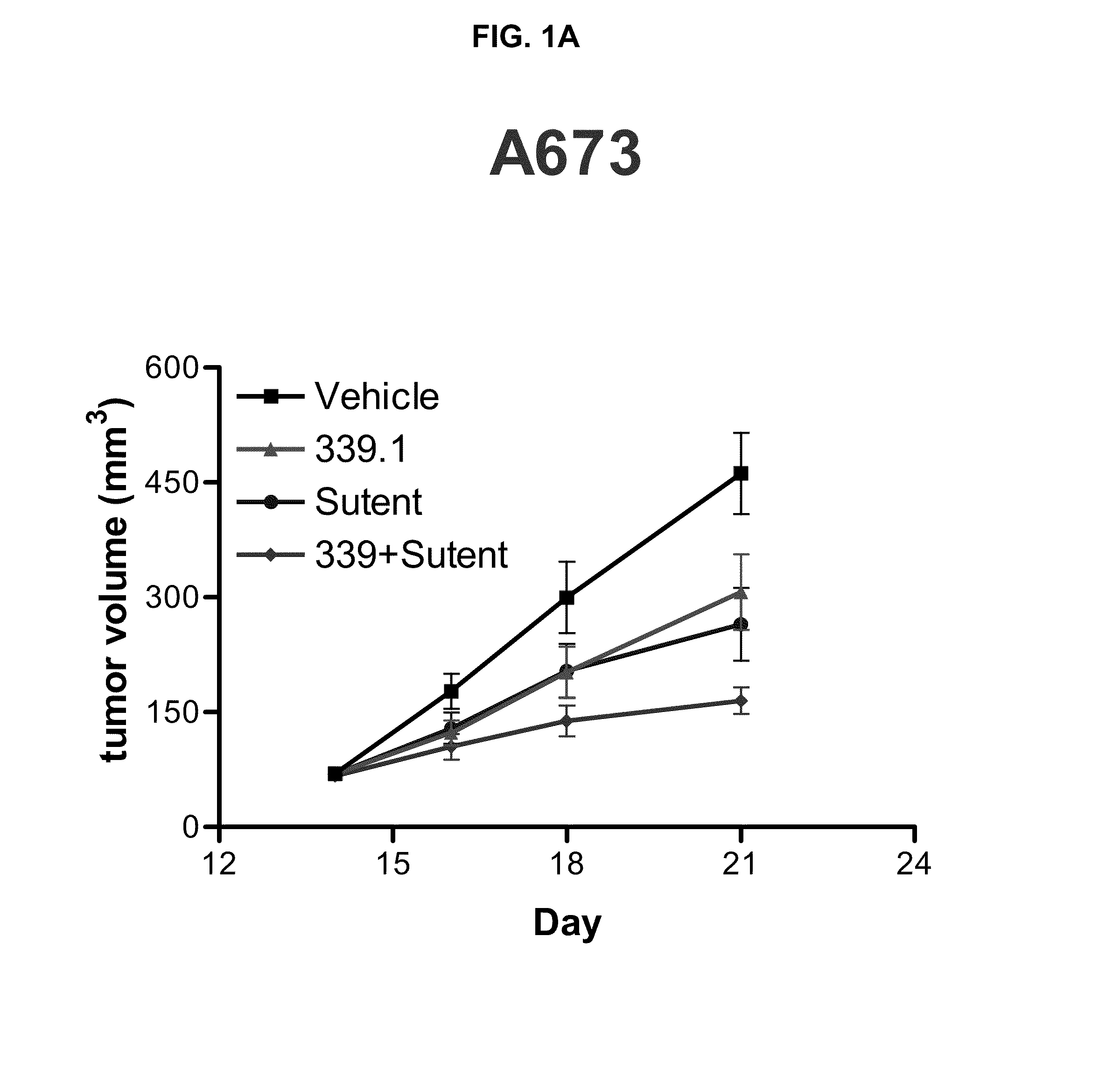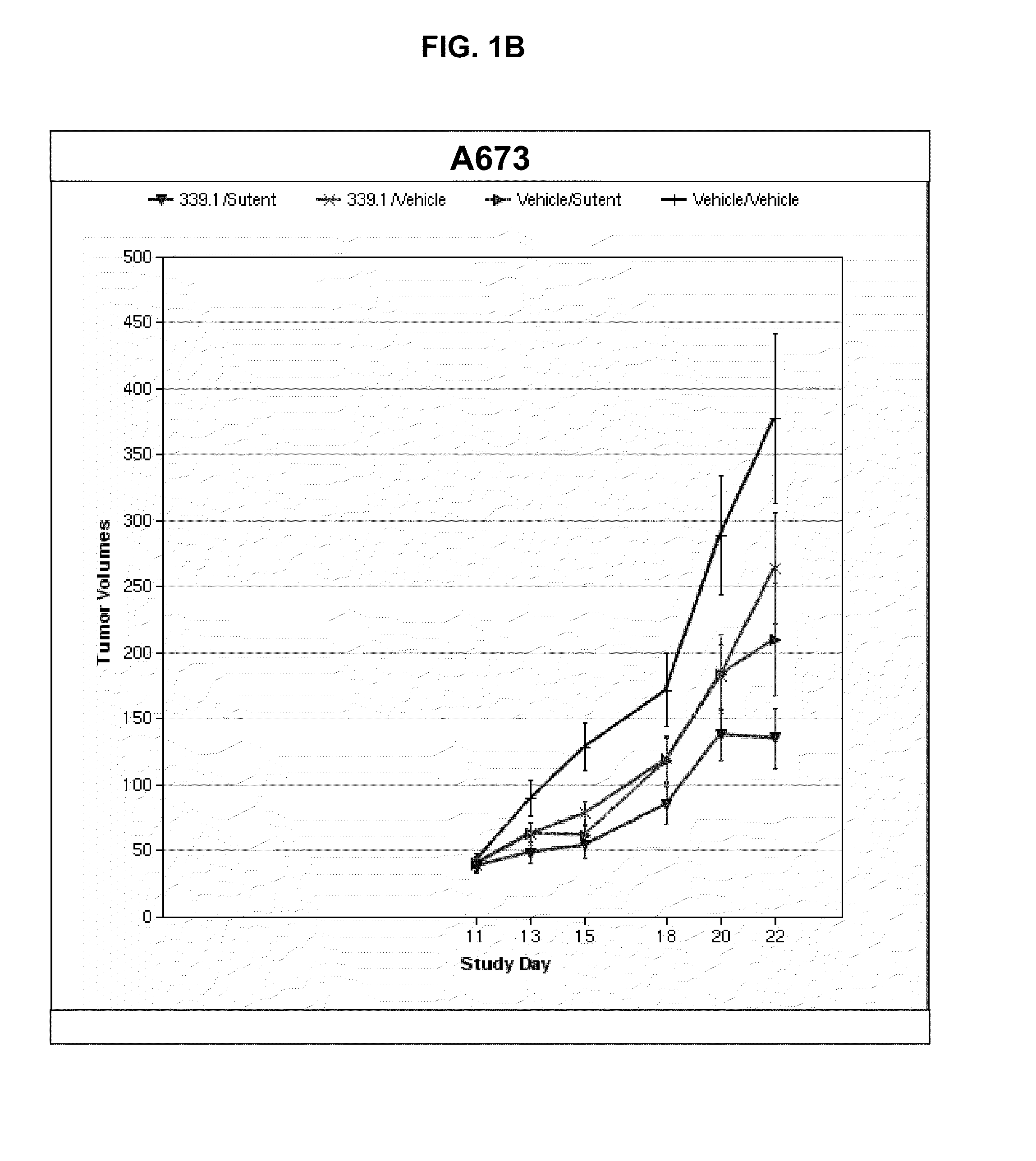Pharmaceutical combinations
a technology of integrin antagonists and combinations, applied in the field of pharmaceutical combinations, can solve the problems of numerous undesirable side effects of each of these treatments
- Summary
- Abstract
- Description
- Claims
- Application Information
AI Technical Summary
Benefits of technology
Problems solved by technology
Method used
Image
Examples
example 1
[0086]This example illustrates a study of the effect of the tyrosine kinase inhibitor, SUTENT® in combination with the α5β1 integrin antagonist, 339.1 antibody, which is a volociximab analog. The study was performed using three different pre-clinical mouse xenograft tumor models of cancer: rhabdomysosarcoma (A673), renal cancer (SN-12C), and renal cancer (786-0).
[0087]The surrogate antibody, 339.1 was used, rather than volociximab, in these mouse xenograft experiments because volociximab does not cross-react with murine α5β1 integrin. The 339.1 antibody targets murine α5β1, with properties similar to volociximab, which targets human α5β1. The amino acid sequences of the 339.1 heavy chain variable region (SEQ ID NO: 22) and 339.1 light chain variable region (SEQ ID NO: 23) are shown in the attached sequence listing. Thus, it was contemplated that the use of the mouse analog of volociximab would provide a better measure of efficacy because it could target angiogenic effects on xenogra...
example 2
[0090]This example illustrates a study of the combinatorial effects of SUTENT®, volociximab and the voloxicimab analog, 339.1, using a pre-clinical model of cancer. Specifically, the studies were performed using a mouse xenograft tumor model of renal cancer (786-0).
[0091]Volociximab was used in this study in addition to the volociximab surrogate antibody, 339.1 in order to model the full anti-tumor effect of treatment of a human cancer patient using a pharmaceutical composition comprising volociximab. The 339.1 antibody is able to target the murine vasculature that develops to support the tumor xenograft model while volociximab is able to target the human α5β1 integrin in the human 786.0 tumor cells. Consequently, it is expected that the combination of volociximab and 339.1 in the xenograft model will more closely model the results of clinical study of volociximab in humans by targeting both the tumor and the vasculature.
[0092]In these experiments, mice bearing established xenograft...
example 3
[0095]This Example illustrates a study of the combinatorial effects of the pharmaceutical combination of NEXAVAR®, volociximab and the voloxicimab analog, 339.1 using the mouse xenograft tumor model of renal cancer (786-0).
[0096]As explained above in Example 2, voliciximab was used in addition to the surrogate antibody, 339.1, because the 339.1 antibody is able to target the murine vasculature that develops to support the tumor xenograft model while volociximab is able to target the human α5β1 integrin in the human 786.0 tumor cells. Consequently, it is expected that the combination of volociximab and 339.1 in the xenograft model will more closely model the results of clinical study of volociximab in humans by targeting both the tumor and the vasculature.
[0097]In these experiments, mice bearing established xenograft tumors were treated with vehicle and vehicle, vehicle and NEXAVAR®, 339.1+volociximab and vehicle, or 339.1+volociximab and NEXAVAR®. The 339.1 antibody and volociximab ...
PUM
| Property | Measurement | Unit |
|---|---|---|
| Fraction | aaaaa | aaaaa |
| Molar density | aaaaa | aaaaa |
| Molar density | aaaaa | aaaaa |
Abstract
Description
Claims
Application Information
 Login to View More
Login to View More - R&D
- Intellectual Property
- Life Sciences
- Materials
- Tech Scout
- Unparalleled Data Quality
- Higher Quality Content
- 60% Fewer Hallucinations
Browse by: Latest US Patents, China's latest patents, Technical Efficacy Thesaurus, Application Domain, Technology Topic, Popular Technical Reports.
© 2025 PatSnap. All rights reserved.Legal|Privacy policy|Modern Slavery Act Transparency Statement|Sitemap|About US| Contact US: help@patsnap.com



